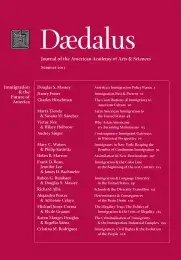
America’s Immigration Policy Fiasco
Douglas Massey discusses how and why U.S. policies intended to stop Latin American immigration to the United States not only failed, but proved counterproductive by ultimately accelerating the rate of both documented and undocumented migration from Mexico and Central America to the United States. As a result, the Latino population grew much faster than demographers had originally projected and the undocumented population grew to an unprecedented size.
Immigration Past & Present
Immigration has remade and changed American society since the nation's founding, and an understanding of the past can help illuminate the immigrant experience in the present. This essay focuses on three central questions: What is new about the most recent immigrant wave? What represents continuity or parallels with the past? And how have migrant inflows in earlier historical periods changed the social, economic, political, and cultural contexts that now greet – and shape the experiences of – the latest arrivals?
The Contributions of Immigrants to American Culture
The standard account of American immigration focuses on the acculturation and assimilation of immigrants and their children to American society. This analysis typically ignores the significant contributions of immigrants to the creation of American culture through the performing arts, sciences, and other cultural pursuits. Immigrants and their children are not born with more creative talents than native-born citizens, but their selectivity and marginality may have pushed and pulled those with ability into high-risk career paths that reward creative work.
Latin American Immigration to the United States
This essay provides an overview of immigration from Latin America since 1960, focusing on changes in both the size and composition of the dominant streams and their cumulative impact on the U.S. foreign-born population. Marta Tienda and Susana M. Sánchez briefly describe the deep historical roots of current migration streams and the policy backdrop against which migration from the region surged.
Why Asian Americans are Becoming Mainstream
In contrast to earlier waves of immigration, the post–1965 Asian immigration to the United States has not spawned an exclusionist backlash among native whites. Rather, the new Asian immigrants and their children are rapidly gaining access to the American mainstream. Whether in integrated residential communities, in colleges and universities, or in mainstream workplaces, Asian Americans’ presence is ever more the rule, not the exception.
Contemporary Immigrant Gateways in Historical Perspective
This article focuses on settlement trends of immigrants during the periods that bookend the twentieth century, both eras of mass migration. It compares settlement patterns in both periods, describing old and new gateways, the growth of the immigrant population, and geographic concentration and dispersion. Historically, immigrants have been highly concentrated in a few places.
Immigrants in New York City: Reaping the Benefits of Continuous Immigration
Using New York City as an example, this essay examines how American cities that have a long and continuous history of absorbing immigrants develop welcoming institutions and policies for current immigrants and their children. Cities such as Chicago, San Francisco, and New York have been gateway cities for many previous waves of immigrants and continue to absorb new immigrants today.
Assimilation in New Destinations
Helen Marrow outlines a long-term research agenda on immigrant assimilation by calling on scholars to be more explicit about how they model and measure assimilation, and to move away from previously aspatial approaches to the topic. After briefly overviewing the field, she draws on original qualitative data from a new immigrant destination region to highlight several places where she believes scholars can better clarify definitions of and assumptions about assimilation, as well as choices about and interpretations of data, to foster transparency and facilitate scholarly discovery.
Immigration & the Color Line at the Beginning of the 21st Century
The “color line” has long served as a metaphor for the starkness of black/white relations in the United States. Yet post-1965 increases in U.S. immigration have brought millions whose ethnoracial status seems neither black nor white, boosting ethnoracial diversity and potentially changing the color line. After reviewing past and current conceptualizations of America's racial divide(s), we ask what recent trends in intermarriage and multiracial identification – both indicators of ethnoracial boundary dissolution – reveal about ethnoracial color lines in today's immigrant America.
Immigration & Language Diversity in the United States
While the United States historically has been a polyglot nation characterized by great linguistic diversity, it has also been a zone of language extinction in which immigrant tongues fade and are replaced by monolingual English within a few generations. In 1910, 10 million people reported a mother tongue other than English, notably German, Italian, Yiddish, and Polish. The subsequent end of mass immigration from Europe led to a waning of language diversity and the most linguistically homogenous era in American history.
Schools & the Diversity Transition
In the next quarter century, North American and Western European societies will face a profound transformation of their working-age populations as a result of immigration, combined with the aging of native majorities. These changes will intensify the challenges of integrating the children of low status immigrants.
Modernization for Emigration: Determinants & Consequences of the Brain Drain
This essay reviews existing theories of professional emigration as background to examine the present situation. Classical theories of the brain drain neglected the possibility that immigrant professionals would return to their home countries and make significant investments and economic contributions there.
The Illegality Trap: The Politics of Immigration & the Lens of Illegality
The focus on undocumented immigrants in contemporary U.S. immigration debates, often at the expense of other immigration issues, has led to an illegality trap. This situation has serious negative consequences for both U.S. immigration policy and immigrants, including an overwhelming emphasis on enforcement; legislative gridlock and the failure of comprehensive immigration reform; constitutional conflict resulting from tensions between national, state, and local approaches to dealing with undocumented immigration; and the puzzling absence of federal policies addressing immigrant integration.
The Criminalization of Immigrants & the Immigration-Industrial Complex
Over the last few decades, and particularly after 9/11, we have witnessed the increasing criminalization of immigrants in the United States. Changing policies have subjected immigrants to intensified apprehension and detention programs. This essay provides an overview of the context and policies that have produced the rising criminalization of immigrants.
Immigration, Civil Rights & the Evolution of the People
In considering what it means to treat immigration as a “civil rights” matter, Cristina Rodríguez identifies two frameworks for analysis. The first, universalistic in nature, emanates from personhood and promises non-citizens the protection of generally applicable laws and an important set of constitutional rights. The second seeks full incorporation for non-citizens into “the people,” a composite that evolves over time through social contestation – a process that can entail enforcement of legal norms but that revolves primarily around political argument.
